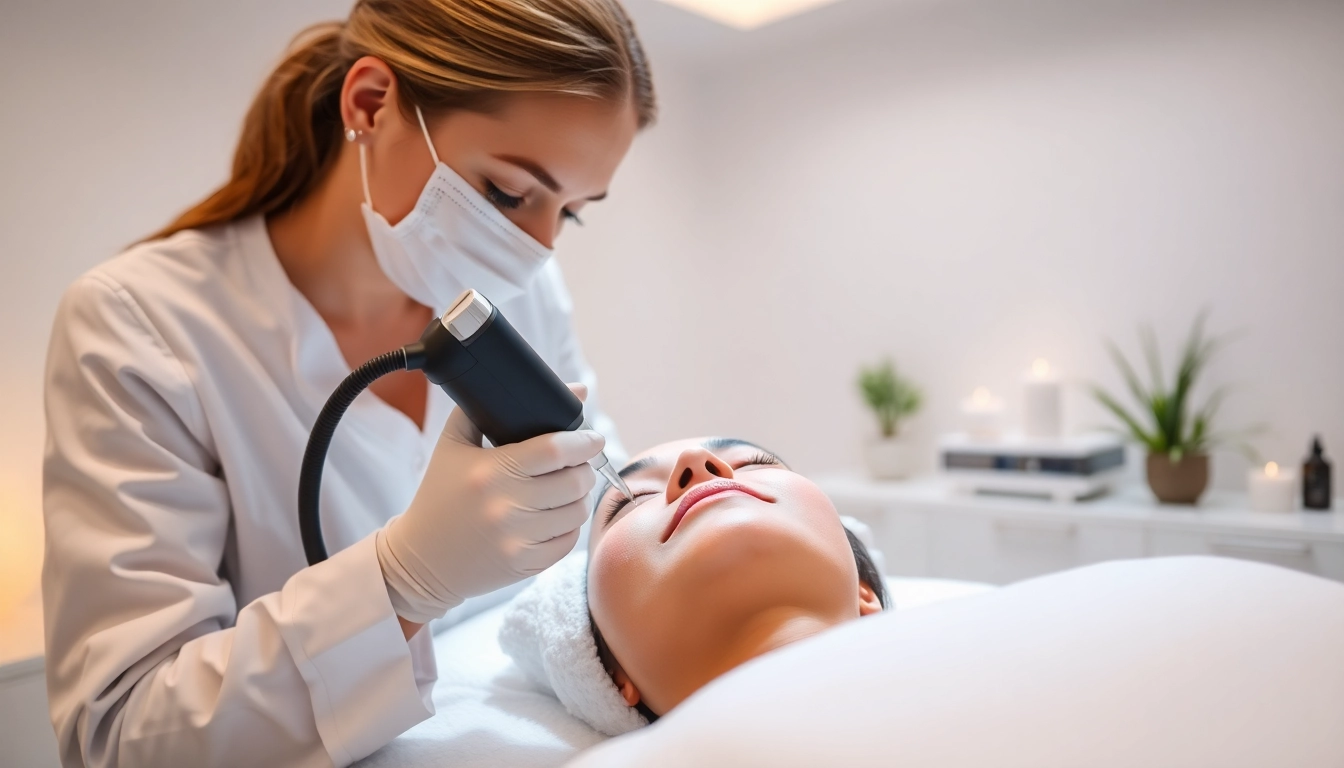What is RF Microneedling?
Definition and Overview
RF microneedling is an innovative cosmetic procedure that combines the benefits of traditional microneedling with the advanced technology of radiofrequency energy. This hybrid technique aims to rejuvenate the skin, improve its texture, and address various skin imperfections. By deploying tiny needles to create micro-injuries in the skin, RF microneedling enhances collagen and elastin production while simultaneously delivering radiofrequency energy deep into the skin layers. This dual action not only promotes healing and skin regeneration but also tightens and lifts the skin, offering a comprehensive solution for various skin concerns. For those interested in exploring this treatment further, RF microneedling could serve as an exemplary option.
How RF Microneedling Works
The RF microneedling procedure begins with the application of a topical anesthetic to ensure patient comfort. Once the skin is adequately numbed, a handheld device fitted with fine needles is used to create controlled micro-injuries. As the device penetrates the skin, it also delivers targeted radiofrequency energy into the dermis layer, enhancing the overall treatment effects. This process results in immediate collagen contraction, followed by a gradual increase in collagen production over the weeks post-treatment.
The depth and intensity of the treatment can be tailored to meet individual skin needs, making it suitable for various skin types and concerns. Typical areas treated include the face, neck, and décolleté, but the technology can also be effectively utilized on other body parts. The harmony between mechanical and thermal stimulation helps in achieving smoother, firmer skin with reduced pore size and the improvement of scars and wrinkles.
Comparison to Traditional Microneedling
While both RF microneedling and traditional microneedling aim to promote skin rejuvenation, they differ in their mechanisms and outcomes. Traditional microneedling solely focuses on creating micro-injuries to stimulate healing and collagen production. In contrast, RF microneedling enhances this effect by introducing thermal energy, which leads to more pronounced lifting and tightening effects.
Furthermore, RF microneedling can penetrate deeper layers of skin without causing the same level of downtime associated with traditional microneedling. Patients often report quicker healing times and improved results over a series of treatments compared to its predecessor. Essentially, RF microneedling combines the benefits of both procedures, potentially offering superior results with a more comfortable experience.
Benefits of RF Microneedling
Skin Tightening and Texture Improvement
One of the standout benefits of RF microneedling is its ability to tighten the skin effectively. The dual action of collagen stimulation and dermal remodeling results in a firmer and smoother appearance. Many patients notice an immediate lifting effect, which continues to improve over the following months as collagen production increases.
In addition to tightening, RF microneedling creates a more even skin texture, reducing the visibility of fine lines, wrinkles, and rough patches. The treatment encourages healthy skin renewal while helping to address the signs of aging, making it an attractive option for those looking for non-invasive ways to achieve youthful skin.
Targeting Scars and Stretch Marks
RF microneedling is particularly effective for treating acne scars and stretch marks due to its ability to penetrate deeper layers of the skin. By stimulating collagen production within the dermis, it helps to replace damaged skin cells with healthy ones. Patients with atrophic scars often see significant improvement after several sessions.
For stretch marks, the RF energy helps to remodel the collagen and elastin fibers, making the skin smoother and more resilient. As the treatment promotes skin healing, individuals can achieve a reduction in scar visibility over time.
Minimizing Pore Size and Fine Lines
Another benefit of RF microneedling is its efficiency in minimizing pores and fine lines. The treatment works by tightening the skin around pores, making them appear smaller. Additionally, as collagen builds up, skin texture improves, contributing to the overall youthful appearance.
Fine lines around the eyes and mouth are also remarkably diminished, as the new collagen fills in the skin’s matrix. This results in a smoother complexion that reflects a more refreshed and rejuvenated look.
What to Expect During the Procedure
Preparation Steps for Patients
Prior to the RF microneedling session, patients should follow specific preparation steps to ensure the best outcome. A thorough consultation with a qualified provider is essential to discuss medical history, expectations, and any potential risks. During this session, it is crucial to disclose any medications, skincare products currently in use, or any prior cosmetic procedures.
Patients may be advised to discontinue certain medications or skincare regimens that can increase skin sensitivity, such as retinoids or blood thinners, a week before the treatment. Additionally, staying hydrated and using sunscreen regularly is recommended to prepare the skin effectively.
The Treatment Experience Explained
The RF microneedling procedure itself typically lasts between 30 to 90 minutes, depending on the area being treated. After the application of the topical anesthetic, the provider will systematically pass the microneedling device over the targeted areas, creating thousands of micro-channels while delivering radiofrequency energy.
Many patients experience slight discomfort, but this is usually well-tolerated due to the numbing agents applied beforehand. The sensation is often compared to a light prickling or warm feeling in the treated areas.
Pain Management and Comfort Techniques
Pain management during RF microneedling primarily involves the use of topical anesthetics, ensuring that patients remain comfortable throughout the procedure. Depending on individual pain tolerance, additional comfort measures may include cooling devices or soothing post-treatment serums. Most practitioners will have protocols in place to monitor patient comfort and adjust the procedure accordingly, ensuring a positive experience.
Aftercare Following RF Microneedling
Immediate Aftercare Tips
After the RF microneedling procedure, the skin may exhibit redness and slight swelling similar to a mild sunburn. Patients are advised to avoid strenuous exercise, saunas, and hot showers for at least 24 hours post-treatment. Additionally, applying a gentle moisturizer and avoiding harsh skincare products is key during the healing phase.
For the first 48 hours, it is important to stay hydrated and protect the skin from sun exposure by applying a broad-spectrum sunscreen throughout the day. These measures can help facilitate the healing process significantly.
Long-Term Skin Care Recommendations
Following RF microneedling, patients should develop a consistent skincare regimen to maintain and enhance results. This may include incorporating serums and moisturizers that promote hydration and skin healing. Ingredients like hyaluronic acid, peptides, and antioxidants are beneficial for post-treatment recovery and long-term skin health.
Regular use of sunscreen also remains paramount, as UV exposure can damage newly formed collagen and impact the results of the treatment. Consulting with a skincare professional can help customize an effective post-treatment routine tailored to individual skin needs.
Common Side Effects to Monitor
While RF microneedling is generally considered safe, patients should be aware of potential side effects. Common side effects include mild redness, swelling, and occasional bruising at the injection sites. In rare cases, patients may experience prolonged discomfort, infection, or skin discoloration. Monitoring the skin closely following the procedure and seeking advice from a healthcare provider if unusual symptoms arise is important for ensuring a successful recovery.
Choosing the Right Provider for RF Microneedling
Qualifications and Experience to Look For
Selecting the right provider for RF microneedling is crucial for achieving optimal results. Look for licensed practitioners, such as dermatologists or licensed medical aestheticians, who have specialized training in RF microneedling technologies. It is essential to inquire about their experience level, including the number of procedures they have performed and their familiarity with various skin types.
Additionally, reviewing before-and-after photos from past clients can provide insight into the provider’s skill set and aesthetic outcomes. Patient testimonials and online reviews can further help establish the credibility and reputation of the practitioner.
Consultation: What Questions to Ask
During the initial consultation, prospective clients should feel empowered to ask questions that address their concerns about the treatment. Key topics to cover include:
- Understanding the expected outcomes and recovery process
- Discussing the total number of sessions needed and their frequency
- Inquiring about specific techniques used in the procedure
- Clarifying any potential risks and how to manage them
A thorough consultation allows patients to gauge the practitioner’s approachability and ensures that they feel confident and informed about their treatment choices.
Understanding Cost and Value of Treatment
The cost of RF microneedling can vary significantly based on factors such as geographical location, the experience of the provider, and the complexity of individual cases. While some may find the treatment to be an investment, it is important to consider the long-term benefits of healthier, rejuvenated skin. Most clinics will offer bundled treatment packages, which can reduce the overall cost per session.
It is beneficial for patients to assess the value of the treatment in relation to their specific skin concerns and objectives. Opting for treatment with a reputable provider may yield higher-value results, making the initial cost worthwhile in the long term.



